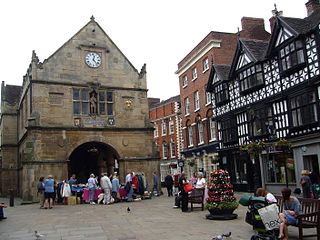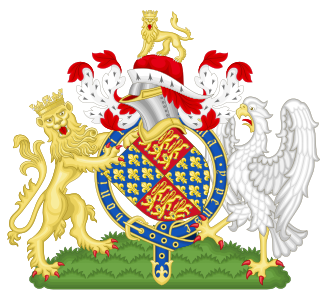
A market town is a settlement most common in Europe that obtained by custom or royal charter, in the Middle Ages, a market right, which allowed it to host a regular market; this distinguished it from a village or city. In Britain, small rural towns with a hinterland of villages are still commonly called market towns, as sometimes reflected in their names.

Serge is a type of twill fabric that has diagonal lines or ridges on both sides, made with a two-up, two-down weave. The worsted variety is used in making military uniforms, suits, great coats and trench coats. Its counterpart, silk serge, is used for linings. French serge is a softer, finer variety. The word is also used for a high-quality woven woolen fabric.

Broadcloth is a dense, plain woven cloth, historically made of wool. The defining characteristic of broadcloth is not its finished width but the fact that it was woven much wider and then heavily milled in order to shrink it to the required width. The effect of the milling process is to draw the yarns much closer together than could be achieved in the loom and allow the individual fibres of the wool to bind together in a felting process, which results in a dense, blind face cloth with a stiff drape which is highly weather-resistant, hard wearing and capable of taking a cut edge without the need for being hemmed.

The Company of Merchant Adventurers of London was a trading company founded in the City of London in the early 15th century. It brought together leading merchants in a regulated company in the nature of a guild. Its members' main business was exporting cloth, especially white (undyed) broadcloth, in exchange for a large range of foreign goods. It traded in northern European ports, competing with the Hanseatic League. It came to focus on Hamburg.
In European historiography, the term "staple" refers to the entire medieval system of trade and its taxation; its French equivalent is étape, and its German equivalent stapeln, words deriving from Late Latin stapula with the same meaning, derived from stabulum. designating a system that Hadrianus Junius considered to be of Gaulish origin.

The Ordinance of the Staple was an ordinance issued in the Great Council in October 1353. It aimed to regularise the status of staple ports in England, Wales, and Ireland. In particular, it designated particular ports where specific goods could be exported or imported. These were called the 'staple ports'. It also established dedicated courts, known as the courts of staple, where disputes relating to commercial matters could be heard, in preference to the courts of common law.

A wool-stapler is a dealer in wool. The wool-stapler buys wool from the producer, sorts and grades it, and sells it on to manufacturers.
The Intercursus Magnus was a major and long-lasting commercial treaty signed in February 1496 by King Henry VII of England and Duke Philip IV of Burgundy. Other signatories included the commercial powers of Venice, Florence, the Netherlands, and the Hanseatic League.
Sir William Cockayne (Cokayne) was a seventeenth-century merchant, alderman, and Lord Mayor of the City of London.
Mercery (from French mercerie, meaning "habderdashery" or "haberdashery" initially referred to silk, linen and fustian textiles among various other piece goods imported to England in the 12th century. Eventually, the term evolved to refer to a merchant or trader of textile goods, especially imported textile goods, particularly in England. A merchant would be known as a mercer, and the profession as mercery.

The medieval English saw their economy as comprising three groups – the clergy, who prayed; the knights, who fought; and the peasants, who worked the landtowns involved in international trade. Over the five centuries of the Middle Ages, the English economy would at first grow and then suffer an acute crisis, resulting in significant political and economic change. Despite economic dislocation in urban and extraction economies, including shifts in the holders of wealth and the location of these economies, the economic output of towns and mines developed and intensified over the period. By the end of the period, England had a weak government, by later standards, overseeing an economy dominated by rented farms controlled by gentry, and a thriving community of indigenous English merchants and corporations.
Sir John York or Yorke (c.1490-1569) was an English merchant and landowner who became Master of the Mint and a Member of Parliament.
The economics of English towns and trade in the Middle Ages is the economic history of English towns and trade from the Norman invasion in 1066, to the death of Henry VII in 1509. Although England's economy was fundamentally agricultural throughout the period, even before the invasion the market economy was important to producers. Norman institutions, including serfdom, were superimposed on a mature network of well established towns involved in international trade. Over the next five centuries the English economy would at first grow and then suffer an acute crisis, resulting in significant political and economic change. Despite economic dislocation in urban areas, including shifts in the holders of wealth and the location of these economies, the economic output of towns developed and intensified over the period. By the end of the period, England would have a weak early modern government overseeing an economy involving a thriving community of indigenous English merchants and corporations.
Sir Richard Lyons (1310–1381) was a prosperous City of London merchant, financier, and property developer, who held a monopoly on the sale of sweet wine in London, during the 14th century. He was a Privy Counsellor, an Alderman of the City, and a member of the Worshipful Company of Vintners, and served as both as Sheriff of London and MP for Essex.

Scottish trade in the Middle Ages includes all forms of economic exchange in the modern boundaries of Scotland and between that region with outside locations, between the departure of the Romans from Britain in the fifth century and the establishment of the Renaissance in the early sixteenth century. There are not the detailed custom accounts for most of the period that exist for England, that can provide an understanding of foreign trade. In the early Middle Ages the rise of Christianity meant that wine and precious metals were imported for use in religious rites. Imported goods found in archaeological sites of the period include ceramics and glass, while many sites indicate iron and precious metal working. The slave trade was also important and in the Irish Sea it may have been stimulated by the arrival of the Vikings from the late eighth century.

Scottish trade in the early modern era includes all forms of economic exchange within Scotland and between the country and locations outwith its boundaries, between the early sixteenth century and the mid-eighteenth. The period roughly corresponds to the early modern era, beginning with the Renaissance and Reformation and ending with the last Jacobite risings and the beginnings of the Industrial Revolution.

The medieval English wool trade was one of the most important factors in the medieval English economy. The medievalist John Munro notes that "[n]o form of manufacturing had a greater impact upon the economy and society of medieval Britain than did those industries producing cloths from various kinds of wool." The trade's liveliest period, 1250–1350, was 'an era when trade in wool had been the backbone and driving force in the English medieval economy'.
Baltic maritime trade began in the Late Middle Ages and would continue to develop into the early modern period. During this time, ships carrying goods from the Baltic and North Sea passed along the Øresund, or the Sound, connecting areas like the Gulf of Finland to the Skagerrak. Over a period of 400 years, maritime powers in the east and west struggled to control these markets and the trade routes between them. The Baltic trading system of this era can be explained as beginning with the Hanseatic League and ending with the Great Nordic War.

The Shrewsbury Drapers Company was a trade organisation founded in 1462 in the town of Shrewsbury, Shropshire, England. The members were wholesale dealers in wool and later woollen cloth. The Company dominated the trade in Welsh cloth and in 1566 was given a regional monopoly in the Welsh Wool trade. In the seventeenth century the trade had difficulties particularly during the English Civil war and then further declined in the eighteenth century with the industrialisation of cloth production and the improvement of transport infrastructure. This made it practical for merchants from Liverpool and elsewhere to travel into Wales and purchase cloth directly from the producers. The Reform Acts of the early nineteenth century took away the power of the trade guilds and the trade ceased. Since that time the Shrewsbury Drapers Company has survived and continues as a charity that runs almshouses in Shrewsbury.
Sir Thomas Offley was a Sheriff of London and Lord Mayor of London during the reign of Queen Mary I of England. A long-serving alderman of London, he was a prominent member of the Worshipful Company of Merchant Taylors, thrice Mayor of the Staple, and a named founding Assistant of the Muscovy Company.










